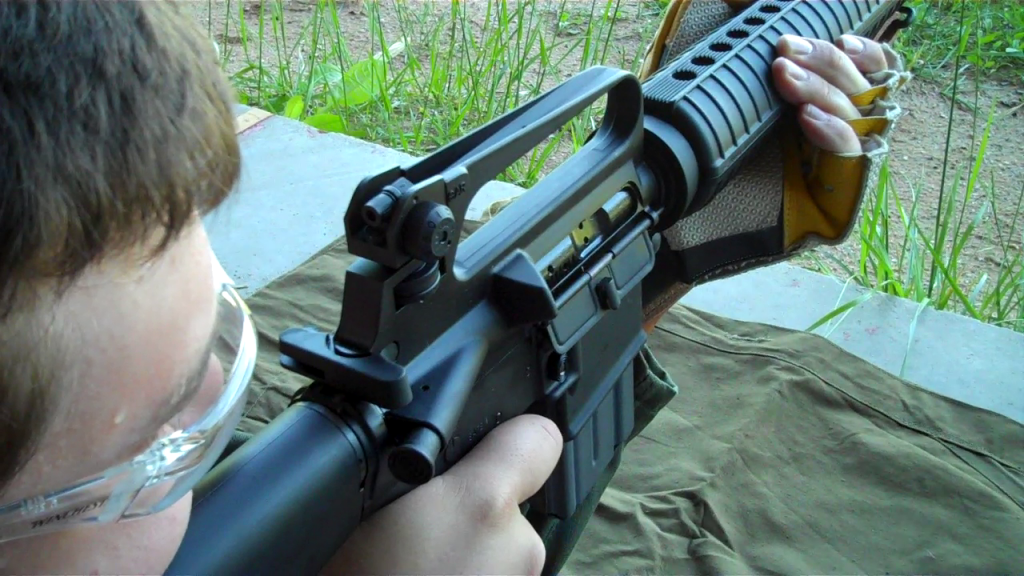Just when you thought you were safe from the boxplots, I bring you another mathematics filled post about ammunition consistency! Well, not mathematics filled, but more than you’d anticipate outside a statistics classroom. This week we’re testing Nosler’s Custom Varmint ammunition, a 40-grain treat for your .223 Remington rifle of choice.
We went over the testing procedure in our first installment of this series. Here’s the basic recap: we fire 20 rounds of this stuff through a chronograph using ArmaLite’s National Match AR-15 and then compare the interquartile range of the velocities to determine which is the most consistent ammunition. More consistent ammunition will make better groups (and more accurate long range shots). For our purposes here, it’s “better.”
Nosler sent us a sample of their 40gr varmint rounds for the .223 Remington caliber. Why they sent varmint ammunition instead of match ammunition (which they also sell) is a mystery. But if you send it TTAG will shoot it.
 In these boxplots I’ve included the top three ammunition brands tested so far. In terms of sheer velocity Nosler’s 40gr varmint rounds are about 1,000 feet per second faster than the Wilson or Hornaday rounds. Thanks to their light weight (almost half the weight of either) they bleed off their velocity much quicker than the competition. They’re also prone to be affected by wind at long distances.
In these boxplots I’ve included the top three ammunition brands tested so far. In terms of sheer velocity Nosler’s 40gr varmint rounds are about 1,000 feet per second faster than the Wilson or Hornaday rounds. Thanks to their light weight (almost half the weight of either) they bleed off their velocity much quicker than the competition. They’re also prone to be affected by wind at long distances.
 This boxplot displays the different ammunition brands normalized by the mean of the velocities (to better illustrate the difference in consistency). As you can see, there’s no competition between Nosler’s offering and the mighty Wilson Combat 77gr.
This boxplot displays the different ammunition brands normalized by the mean of the velocities (to better illustrate the difference in consistency). As you can see, there’s no competition between Nosler’s offering and the mighty Wilson Combat 77gr.
 This bar graph compares the interquartile range of every ammunition brand we’ve tested so far, with Nosler highlighted in red. Nosler’s ammunition is the least consistent brand we’ve tested so far, but it’s also the lightest in terms of bullet weight.
This bar graph compares the interquartile range of every ammunition brand we’ve tested so far, with Nosler highlighted in red. Nosler’s ammunition is the least consistent brand we’ve tested so far, but it’s also the lightest in terms of bullet weight.
Here’s the test results so far. We’ll be adding more ammunition brands as we continue testing to find the world’s most consistent factory ammunition.
| Brand and Weight | Caliber | IQR |
| Wilson Combat 77gr Sierra HPBT Match |
.223 Rem | 19 |
| Wilson Combat 65gr Sierra SP BT |
.223 Rem | 21 |
| Hornaday 75gr BTHP Match |
.223 Rem | 29 |
| CorBon 69gr HPBT |
.223 Rem | 30 |
| Winchester 64gr “Power Point” SP |
.223 Rem | 38 |
| Wolf 55gr FMJ |
.223 Rem | 40 |
| Federal XM193F 55gr FMJ |
.223 Rem | 40 |
| Nosler Varmint 40gr Ballistic Tip |
.223 Rem | 44 |
| Handloads – 20.8gr N-135 75gr Hornaday HPBT Match |
.223 Rem | 49 |
| Handloads – 21gr IMR 3031 75gr Hornaday HPBT Match |
.223 Rem | 52 |





You are doing something wrong with your handloads. Something – Maybe just using a standard dropper rather then weighing each charge, using brass from different batches, improper neck tension, case prep, etc.
My quickly produced plinking .38 loads chrono better than your testing above. Have better results with every load I have developed over the past quarter century
Comments are closed.